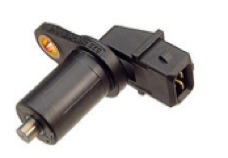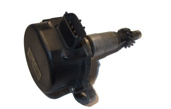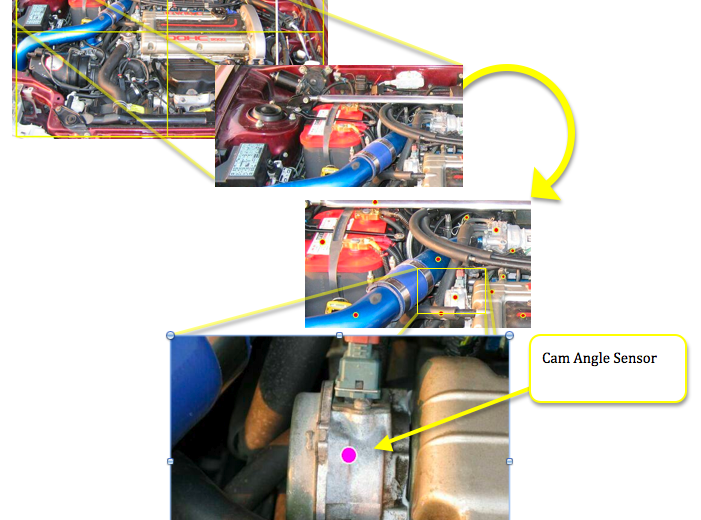| What's Hot! | Products/ Tools | EFI Tuning | Basic Tuning | Advanced Tuning | Chassis Tuning | Advertise with us |
Cam and Crank Angle Sensor


Submitted By: Dallen B.
The Cam Angle Sensor and Crank Angle Sensor are important parts of the Engine. In most cases, the vehicle will not even start without the data from these sensors. In many engines the camshaft is no longer located in the block, but actually in the head. The Crankshaft is located in the block. A chain, or belt connects these and they turn together. The sensor measures the position of the shafts to help calculate many things that the car needs to run:
• Detect where shafts are to tell the Powertrain Control Module (PCM) when to fire the injectors and spark plugs.
• Measure the RPM of the engine so the PCM can increase or decrease the timing.
• Measure the acceleration or deceleration of the car.
Now that we know what the actual sensor does, lets find out how it does it. There are two different kinds of sensors that are used for this process. One is called a magnetic effect sensor, and the other is called the Hall effect sensor.
• The magnetic effect uses a magnet in the sensor to sense notches cut in the crank and cam. As the notches pass the sensor, they create a field in the magnet. This field also creates an alternating current signal that the sensor sends to the PCM to make sense of it all.
• Hall effect is basically the same as the magnetic effect; it just goes the extra mile and makes a digital signal to send to the PCM. Once again, notches are cut in the crank and cam. These are used to disrupt the magnetic field. From this the sensor turns on and off to produce the digital signal the PCM can read. Blades can also be put on the shafts to produce the same effect.
Most new vehicles use the Hall effect sensor to send data to the PCM because the data is in digital form. Essentially the two sensors are the same. But once again, the Hall effect sensor goes the extra mile by outputting a digital signal.
This sensor obviously has importance in the function of the Engine as a whole. Let’s see in one example of where this sensor might be located. The example below is the cam angle sensor on a 4g63 Mitsubishi Eclipse motor. These photos will guide you to where the sensor is located. (click for larger image)
In reality, these sensors are very simple. There isn’t any crazy technology behind them, but they are important. Once again, the car will not start without this sensor or set of sensors properly working. So you could say that they affect the motor in a very big way.

ATTENTION READER:
If you enjoyed the information and article you just read be sure to check out our newly released book with even more exciting photo's and information:How to Turbocharge and Tune your Engine

Want to know more about your particular Make and Model vehicle? All of these vehicles are covered in the tech, maintenance and repair articles found above. Enginebasics is the wiki or wikipedia of car part, repair, how to and tuning information. Let us be the class 101 for your automotive learning.
| Ford | General Motors GM | Pontiac | Jaguar | Land Rover | Nissan |
| Toyota | Honda | Lexus | Acura | Lotus | Scion |
| Infinity | BMW | Mercedes | Mitsubishi | Ferrari | Maserati |
| Lamborghini | Volks Wagen VW | Saab | Audi | Hyundai | Kia |
| Subaru | Mazda | Chevy | Volvo | Caddilac | Dodge |
| Chrylser | Daewoo | Porsche | Mercury | Freightliner | MG |
Individual Models
| Ford Mustang | Mitsubishi Eclipse | Mitsubishi Evo | Subaru WRX / STI | Dodge Viper | Chevrolet Corvette |
| Nissan Skyline | Honda S2000 | Nissan 350z | Toyota Supra | Chevy Camaro | Lotus Elise Exige |
| Honda Civic | VW Golf | Dodge SRT-4 | Eagle Talon | Acura Integra | BMW M3 |
| Nissan 240sx | Porsche 911 | Acura NSX | Honda Accord | Toyota Camry | Toyota MR2 |
| VW R32 | Dodge Truck | Mazda Rx7 | VW Jetta | Sand Buggy | Nissan Sentra |
For the latest Automotive news and stories visit the websites below |
Our feature Build: An AWD V6 Civic





